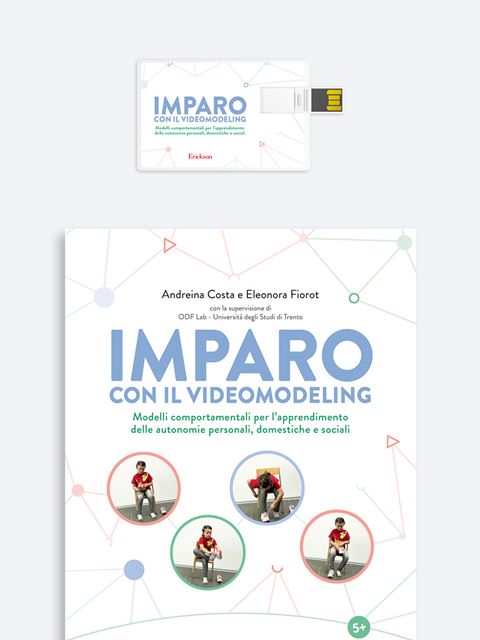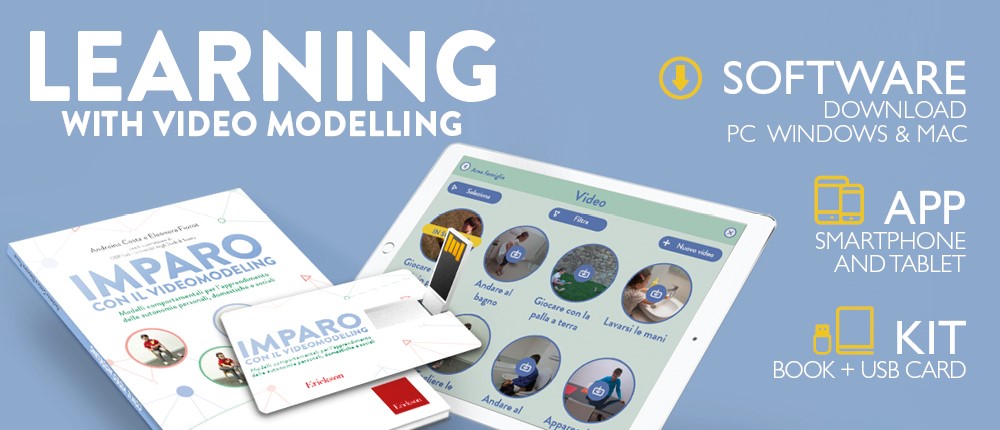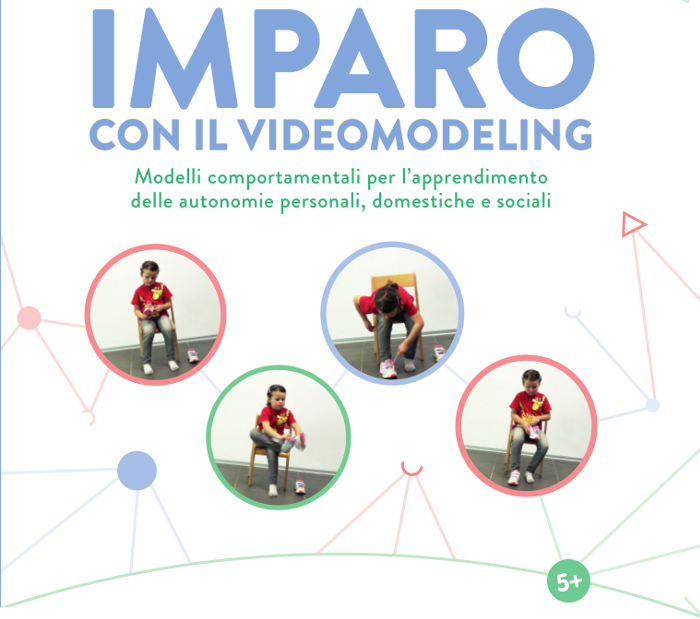 EN
EN
 PT
PT
Behaviour models for learning personal, social, and domestic independence skills

Product: Software
ISBN: 9788859013396
Publication date: 01/03/2018
Suitable for: Primary 1st level (ages 6-7), Primary 2nd level (ages 8-10), Lower secondary 1st level (ages 10-11), Lower secondary 2nd level (ages 12-13), Upper secondary 1st level (ages 14-16), Upper secondary 2nd level (ages 17-19)
REQUEST A SAMPLE OR MORE INFORMATION
THE SOFTWARE
By now, the effectiveness of video modelling has been proven in several areas, including the treatment of children with autism spectrum disorders and with developmental disabilities. Learning with Video Modelling is precisely for them. It is an operative software to support professionals while stimulating the patient’s interest through the proposal and re-elaboration of familiar situations.
Moreover, it is a valuable tool for the family and for those who work with the child/adolescent with difficulty. The software proposes a set of behavioral models for learning by imitating the independent skills related to the personal, communicative and socio-emotional spheres, and which can be customized with new video content created by the professional or the family.
In order to allow targeted access to materials and to encourage the sharing of the learning method among the adults who work with the child, it is possible to use the software in two different ways depending on the user: “Family” and “Professional.” These profiles are linked to each other to create a continuity between the individual sessions with the expert and home activities. Designed primarily for use with children aged 5 years and over, the program can also be used with adults, or elderly people, provided that that the administration of the video content is done appropriately.
The application is structured around two main objectives:
To meet these needs, the software is divided into two main sections, family and professional, with the aim of ensuring a personalized and inherent use of the software to accomplish the learning goals. To these two areas, a third one is added which is dedicated to the child.
Each of the two main areas is divided into three specific sections:
VIDEO: a database with predefined videos divided into video modelling and video prompting, with the ability to add videos and share them with the professional, getting feedback on their effectiveness and functionality.
PLACES: a section where it is possible to take pictures of environments frequented by the child and insert links to videos with actions that take place in these contexts.
PROGRESS: the final area where learning progress is recorded, which is also divided into two parts:
• communication: a type of notepad where the professional can write down information inherent to the therapy;
• statistics: graphs which visually display the progress made in acquiring the independent behaviours
The software proposes the creation of a structured connection between family and professionals, exploiting the power of video to guide children towards a greater degree of self-sufficiency in small daily actions.
THE BOOK
The project Learning with Video Modelling arises from the need to identify an effective tool for promoting the learning of essential functional skills in people with autism spectrum disorders and other developmental difficulties.
The volume begins with a theoretical part in which the concept of learning by observation and imitation (modelling) is introduced. This way of learning was theorized and applied for the first time by Bandura towards the end of the ’60s, and from there the development of the video modelling technique was born. Then an analysis of results obtained by Autism and developmental disorder experts using the video modelling technique in the field of Autism spectrum disorders and other clinical areas follows.
After the theoretical part, we proceed with a more operative section, with practical indications on how to make videos that respond adequately to specific needs, about the types of movies it is possible to make (video modelling, self modelling, prompting), on film phases and timing to be followed, on the choice of the actors and the writing of the script, and on all the fundamental aspects to ensure the creation of an optimal video (audio, lights, technological devices, etc.).
The book concludes with a section entirely dedicated to the software, with detailed information on the functions of the program and on how to implement a learning path that is as appropriate as possible to meet the needs of the child/adolescent.
The Professional Version is available, not only as a KIT (book + software on a USB key for Windows and MAC), but also as:
• an APP for smartphones and tablets (Android and Apple)
•a DOWNLOAD (Windows and MAC)
The Family Version is available as an APP for smartphones and tablets (Android and Apple)

A new software designed for professionals working with children on the Autism spectrum and their families

What is video modelling?
Video modelling is a teaching method based on learning through imitation where learning takes place by observing a video showing the correct way to perform a given behavior, or a precise sequence of actions, following the ABA methodology.
What does it consist of?
Technically, video modelling consists of showing the child a videotaped demonstration of a specific target action being performed, lasting a few minutes, and consequently requesting the child to reproduce what has been viewed. The models used in the video recordings should preferably be the same age as the viewer, or even family members, educators, or other adults with whom the child is familiar in order to encourage imitation on the child’s part.
What are the main skills that can be learned with video modelling?
LEARNING WITH VIDEO MODELLING
Created by Andreina Costa and Eleonora Fiorot, under the supervision of the Diagnosis and Training Observation (ODF) Laboratory at the University of Trento, Learning with Video Modelling is an operative software that proposes a series of teaching and reinforcement programs for the main functional skills related to personal, social, and domestic independence.


The program is primarily aimed at professionals who deal with autism spectrum disorders and developmental disabilities but can also be a valuable tool for families and all people who work with children and adolescents with difficulties.
In fact, the software has two distinct modes to choose from: A) “Family,” and B) “Professionals.” The first is closely tied to the second, used by the experts, to create continuity between the therapy sessions and the home life of the child.
The primary user of the software, therefore, is not the child/adolescent with difficulties, but rather the adult who has identified the area of weakness and will then use the software to administer reinforcement tasks and verify the effectiveness of assimilation.
THE MAIN MENU
The main menu is the heart of the software and it is the same for both modes (“Family Mode” and “Professional Mode”).
There are three main areas with different functions: “Videos,” “Places,” and “Progress.”

Videos
The “Video” area is dedicated to managing and viewing videos for learning. It contains the video tools developed to apply the “modelling” program and allows the individual with disabilities to learn by imitation, through a process of repeated observation of the correct way in which a behaviour is carried out.
The preinstalled videos are differentiated by age, divided into three target groups (age 5, ages 9-10 and ages 15-16) and three areas of independence (personal, social and domestic).

Personal Independence |
Social Independence |
Domestic Independence |
|
Age 5 |
• Going to the bathroom • Washing one’s hands • Putting on shoes with straps • Taking off shoes with straps | • Playing with the ball while sitting | |
Ages 9-10 |
• Going to the bathroom • Brushing one’s teeth • Washing one’s hands • Washing one’s face • Putting on socks • Putting on a jacket with help • Putting on a jacket independently • Putting on shoes with straps • Putting on shoes with laces • Preparing the school folder • Taking off a jacket • Taking of shoes with straps | • Crossing the street at the traffic lights • Crossing the street using the pedestrian crossing | • Setting the table • Making the bed • Loading the dishwasher |
Ages 15-16 |
• Getting undressed • Getting dressed | • Buying snacks from a vending machine • Introducing one’s self • Introducing one’s self and playing with others |
Places
In this area, the user can upload pictures of the environments in which the child lives and interacts, for example the home, school, and public places, and create links to the videos using symbols. These videos propose appropriate actions for each place, with the aim of creating an intuitive association between the place and action and allow for greater personalization of the application.

Progress
The “Progress” area is intended to reinforce the connection between the family and the professional, in order to guarantee feedback on the progress made by the child to both parties.
This section is subdivided into two parts: “Communication”—for the exchange of information between all linked devices, and “Statistics”—for monitoring the learning of the target behaviours.


The Professional version is available as:
&The Family version is available as: an APP for smartphones and tablets (Android e Apple)